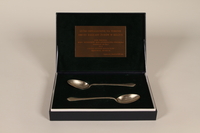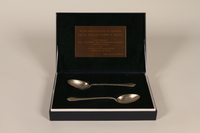Overview
- Brief Narrative
- One of two silver-colored metal spoons recovered from the site of Belzec killing center, and presented to the United States Holocaust Memorial Museum (USHMM) in 1998 by the Polish Government. In 1995, the United States Holocaust Memorial Council and the Polish government arranged for American donors to contribute half the funds for the creation of a memorial on the site of the camp. Prior to construction, archaeologists conducted excavations at the site between 1997 and 1999. In 1941, construction of the killing center began on the site of a former labor camp in southeastern German-occupied Poland. Construction was completed in the winter of 1942 and operations commenced on March 17, 1942. The killing center, and two others, Sobibor and Treblinka II were built for Operation Reinhard, a code name for the plan to kill the two million Jews who resided in specific areas of German-occupied Poland. Prisoners arrived by train and were forced to hand over their possessions, which were sorted and transported back to Germany for redistribution. With the exception of the few selected for labor, incoming prisoners were gassed upon arrival. In October 1942, Jewish laborers were forced to exhume the mass graves and burn the bodies in the open-air on top of old railroad tracks. By June of 1943, the camp was dismantled. Approximately 450,000 Jews were killed from March to December 1942.
- Date
-
recovered:
after 1997-before 1998
received: 1998 July 09
- Geography
-
recovery:
Belzec (Concentration camp);
Belzec (Poland)
- Credit Line
- United States Holocaust Memorial Museum Collection, Gift of the Polish Government
Physical Details
- Classification
-
Household Utensils
- Category
-
Flatware
- Object Type
-
Tablespoons (Flatware) (lcsh)
- Genre/Form
- Spoons.
- Physical Description
- Silver-colored metal spoon with a large, oval-shaped bowl with a flat, narrow, metal stem connected to the wide end. The stem widens slightly and tapers again, forming small, rounded points, then tapers down and continues long and straight, until it reaches the handle, where it widens to form a pointed, beveled, tip. On the top of the spoon, there is a set of five raised lines on the stem and another set of five raised lines where the stem transitions into the handle. On the bottom side, there is a colorless residue on the bottom of the bowl and on the handle.
- Dimensions
- overall: Height: 8.500 inches (21.59 cm) | Width: 1.625 inches (4.128 cm) | Depth: 0.875 inches (2.223 cm)
- Materials
- overall : metal
Rights & Restrictions
- Conditions on Access
- No restrictions on access
- Conditions on Use
- No restrictions on use
Keywords & Subjects
- Topical Term
- Execution sites. Gas chambers. Genocide. Holocaust, Jewish (1939-1945)--Archaeology. Holocaust, Jewish (1939-1945)--Research. Holocaust, Jewish (1939-1945)--Forced labor. Holocaust memorials--Poland. Mass murder--Poland. Operation Reinhard, Poland, 1942-1943. World War, 1939-1945--Jews--Europe. World War, 1939-1945--Occupied territories.
- Geographic Name
- Bełżec (Poland)
Administrative Notes
- Legal Status
- Permanent Collection
- Provenance
- The spoon was donated to the United States Holocaust Memorial Museum in 1998 by the government of the Polish Republic.
- Record last modified:
- 2024-07-16 14:57:28
- This page:
- https://collections.ushmm.org/search/catalog/irn45932
Download & Licensing
In-Person Research
- By Appointment
- Request 21 Days in Advance of Visit
- Plan a Research Visit
- Request to See This Object
Contact Us
Also in Polish Government presentation set collection
The collection consists of a presentation case and two spoons recovered after the war near Belzec killing center in Poland.
Date: 1998

Metal spoon recovered from Belzec killing center
Object
One of two silver-colored metal spoons recovered from the site of Belzec killing center, and presented to the United States Holocaust Memorial Museum (USHMM) in 1998 by the Polish Government. In 1995, the United States Holocaust Memorial Council and the Polish government arranged for American donors to contribute half the funds for the creation of a memorial on the site of the camp. Prior to construction, archaeologists conducted excavations at the site between 1997 and 1999. In 1941, construction of the killing center began on the site of a former labor camp in southeastern German-occupied Poland. Construction was completed in the winter of 1942 and operations commenced on March 17, 1942. The killing center, and two others, Sobibor and Treblinka II were built for Operation Reinhard, a code name for the plan to kill the two million Jews who resided in specific areas of German-occupied Poland. Prisoners arrived by train and were forced to hand over their possessions, which were sorted and transported back to Germany for redistribution. With the exception of the few selected for labor, incoming prisoners were gassed upon arrival. In October 1942, Jewish laborers were forced to exhume the mass graves and burn the bodies in the open-air on top of old railroad tracks. By June of 1943, the camp was dismantled. Approximately 450,000 Jews were killed from March to December 1942.

Presentation box for spoons recovered at Belzec killing center
Object
Modern presentation box for two silver-colored metal spoons that were recovered on the site of Belzec killing center, and presented to the United States Holocaust Memorial Museum in 1998 by the Polish Government. In 1941, construction of the killing center began on the site of a former labor camp in southeastern German-occupied Poland. Construction was completed in the winter of 1942 and operations commenced on March 17, 1942. The killing center, and two others, Sobibor and Treblinka II were built for Operation Reinhard, a code name for the plan to kill the two million Jews who resided in specific areas of German-occupied Poland. Prisoners arrived by train and were forced to hand over their possessions, which were sorted and transported back to Germany for redistribution. With the exception of the few selected for labor, incoming prisoners were gassed upon arrival. In October 1942, Jewish laborers were forced to exhume the mass graves and burn the bodies in the open-air on top of old railroad tracks. By June of 1943, the camp was dismantled. The Germans then ploughed and built a manor on the site, disguising the killing center as a farm. Approximately 450,000 Jews were killed from March to December 1942. In 1995, the United States Holocaust Memorial Council and the Polish government arranged for American donors to contribute half the funds for the creation of a memorial on the site of the camp. Prior to construction, archaeologists conducted excavations at the site between 1997 and 1999.



